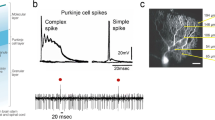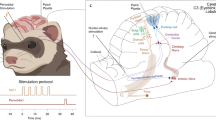Abstract
Cerebellar participation in timing and sensory-motor sequences has been supported by several experimental and clinical studies. A relevant role of the cerebellum in timing of conditioned responses in the range of milliseconds has been demonstrated, but less is known regarding the role of the cerebellum in supra-second timing of operant responses. A dissociated role of the cerebellum and striatum in timing in the millisecond and second range had been reported, respectively. The climbing fibre-Purkinje cell synapse is crucial in timing models; thus, the aberrant connection between these cellular elements is a suitable model for evaluating the contribution of the cerebellum in timing in the supra-second range. The aberrant connection between climbing fibres and Purkinje cells was induced by administration of the antagonist of NMDA receptors MK-801 to Sprague–Dawley rats at postnatal days 7–14. The timing of an operant response with two fixed intervals (5 and 8 s) and egocentric sequential learning was evaluated in 60-day-old adult rats. The aberrant connections caused a reduced accuracy in the timing of the instrumental response that was more evident in the 8-s interval and a reduced number of successive correct responses (responses emitted in the correct second without any other response between them) in the 8-s interval. In addition, an inability to incorporate new information in a sequence previously learned in egocentric-based sequence learning was apparent in rats with aberrant CF–PC synapses. These results support a relevant role for the cerebellum in the fine-tuning of the timing of operant responses in the supra-second range.




Similar content being viewed by others
References
Bengtsson SL, Ehrsson HH, Forssberg H, Ullen F (2005) Effector-independent voluntary timing: behavioural and neuroimaging evidence. Eur J Neurosci 22:3255–3265. doi:10.1111/j.1460-9568.2005.04517.x
Burguiere E, Arabo A, Jarlier F, De Zeeuw CI, Rondi-Reig L (2010) Role of the cerebellar cortex in conditioned goal-directed behavior. J Neurosci 30:13265–13271. doi:10.1523/JNEUROSCI.2190-10.2010
Butler AK, Uryu K, Rougon G, Chesselet MF (1999) N-methyl-d-aspartate receptor blockade affects polysialylated neural cell adhesion molecule expression and synaptic density during striatal development. Neuroscience 89:1169–1181 (pii:S0306-4522(98)00358-3)
Callu D, El Massioui N, Dutrieux G, Brown BL, Doyere V (2009) Cognitive processing impairments in a supra-second temporal discrimination task in rats with cerebellar lesion. Neurobiol Learn Mem 91:250–259. doi:10.1016/j.nlm.2008.12.002
Christian KM, Thompson RF (2003) Neural substrates of eyeblink conditioning: acquisition and retention. Learn Mem 10:427–455. doi:10.1101/lm.59603
Colwell CS, Cepeda C, Crawford C, Levine MS (1998) Postnatal development of glutamate receptor-mediated responses in the neostriatum. Dev Neurosci 20:154–163 (pii:dne20154)
Coull JT, Cheng RK, Meck WH (2011) Neuroanatomical and neurochemical substrates of timing. Neuropsychopharmacology 36:3–25. doi:10.1038/npp.2010.113
Crepel F, Mariani J, Delhaye-Bouchaud N (1976) Evidence for a multiple innervation of Purkinje cells by climbing fibers in the immature rat cerebellum. J Neurobiol 7:567–578. doi:10.1002/neu.480070609
Dickson PE et al (2010) Behavioral flexibility in a mouse model of developmental cerebellar Purkinje cell loss. Neurobiol Learn Mem 94:220–228. doi:10.1016/j.nlm.2010.05.010
Eccles JC, Llinas R, Sasaki K (1966) The excitatory synaptic action of climbing fibres on the Purkinje cells of the cerebellum. J Physiol 182:268–296
Fremeau RT Jr et al (2001) The expression of vesicular glutamate transporters defines two classes of excitatory synapse. Neuron 31:247–260 (pii: S0896-6273(01)00344-0)
Gaytan-Tocaven L, Olvera-Cortes ME (2004) Bilateral lesion of the cerebellar-dentate nucleus impairs egocentric sequential learning but not egocentric navigation in the rat. Neurobiol Learn Mem 82:120–127. doi:10.1016/j.nlm.2004.05.006
Gooch CM, Wiener M, Wencil EB, Coslett HB (2010) Interval timing disruptions in subjects with cerebellar lesions. Neuropsychologia 48:1022–1031. doi:10.1016/j.neuropsychologia.2009.11.028
Hashimoto K, Kano M (2005) Postnatal development and synapse elimination of climbing fiber to Purkinje cell projection in the cerebellum. Neurosci Res 53:221–228. doi:10.1016/j.neures.2005.07.007
Hashimoto K, Kano M (2013) Synapse elimination in the developing cerebellum. Cell Mol Life Sci 70:4667–4680. doi:10.1007/s00018-013-1405-2
Hikosaka O, Miyashita K, Miyachi S, Sakai K, Lu X (1998) Differential roles of the frontal cortex, basal ganglia, and cerebellum in visuomotor sequence learning. Neurobiol Learn Mem 70:137–149. doi:10.1006/nlme.1998.3844
Hikosaka O et al (1999) Parallel neural networks for learning sequential procedures. Trends Neurosci 22:464–471 (pii:S0166-2236(99)01439-3)
Ivry RB (1996) The representation of temporal information in perception and motor control. Curr Opin Neurobiol 6:851–857 (pii:S0959-4388(96)80037-7)
Ivry R (2000) Exploring the role of the cerebellum in sensory anticipation and timing: commentary on Tesche and Karhu. Hum Brain Mapp 9:115–118. doi:10.1002/(SICI)1097-0193(200003)9:3<115:AID-HBM1>3.0.CO;2-5
Ivry RB, Richardson TC (2002) Temporal control and coordination: the multiple timer model. Brain Cogn 48:117–132. doi:10.1006/brcg.2001.1308
Jacobson SW et al (2008) Impaired eyeblink conditioning in children with fetal alcohol syndrome. Alcohol Clin Exp Res 32:365–372. doi:10.1111/j.1530-0277.2007.00585.x
Jantzen KJ, Steinberg FL, Kelso JA (2005) Functional MRI reveals the existence of modality and coordination-dependent timing networks. Neuroimage 25:1031–1042. doi:10.1016/j.neuroimage.2004.12.029
Jueptner M, Rijntjes M, Weiller C, Faiss JH, Timmann D, Mueller SP, Diener HC (1995) Localization of a cerebellar timing process using PET. Neurology 45:1540–1545
Kakizawa S, Yamasaki M, Watanabe M, Kano M (2000) Critical period for activity-dependent synapse elimination in developing cerebellum. J Neurosci 20:4954–4961 (pii:20/13/4954)
Kehoe JE (2006) Repeated acquisitions and extinctions in classical conditioning of the rabbit nictitating membrane response. Learn Mem 13:366–375. doi:10.1101/lm.169306
Lalonde R, Manseau M, Botez MI (1988) Spontaneous alternation and exploration in staggerer mutant mice. Behav Brain Res 27:273–276
Liu T, Xu D, Ashe J, Bushara K (2008) Specificity of inferior olive response to stimulus timing. J Neurophysiol 100:1557–1561. doi:10.1152/jn.00961.2007
Lu X, Hikosaka O, Miyachi S (1998) Role of monkey cerebellar nuclei in skill for sequential movement. J Neurophysiol 79:2245–2254
Malapani C, Dubois B, Rancurel G, Gibbon J (1998) Cerebellar dysfunctions of temporal processing in the seconds range in humans. Neuroreport 9:3907–3912
Mandolesi L, Leggio MG, Spirito F, Petrosini L (2003) Cerebellar contribution to spatial event processing: do spatial procedures contribute to formation of spatial declarative knowledge? Eur J Neurosci 18:2618–2626 (pii:2990)
Mangels JA, Ivry RB, Shimizu N (1998) Dissociable contributions of the prefrontal and neocerebellar cortex to time perception. Brain Res Cogn Brain Res 7:15–39 (pii:S0926-6410(98)00005-6)
Martin LA, Goldowitz D, Mittleman G (2010) Repetitive behavior and increased activity in mice with Purkinje cell loss: a model for understanding the role of cerebellar pathology in autism. Eur J Neurosci 31:544–555. doi:10.1111/j.1460-9568.2009.07073.x
Mauk MD, Donegan NH (1997) A model of Pavlovian eyelid conditioning based on the synaptic organization of the cerebellum. Learn Mem 4:130–158
Molinari M, Leggio MG, Solida A, Ciorra R, Misciagna S, Silveri MC, Petrosini L (1997) Cerebellum and procedural learning: evidence from focal cerebellar lesions. Brain 120(Pt 10):1753–1762
Ohyama T, Mauk M (2001) Latent acquisition of timed responses in cerebellar cortex. J Neurosci 21:682–690 (pii:21/2/682)
Strata P, Rossi F (1998) Plasticity of the olivocerebellar pathway. Trends Neurosci 21:407–413 (pii:S0166-2236(98)01305-8)
Thach WT, Goodkin HP, Keating JG (1992) The cerebellum and the adaptive coordination of movement. Annu Rev Neurosci 15:403–442. doi:10.1146/annurev.ne.15.030192.002155
Tregellas JR, Davalos DB, Rojas DC (2006) Effect of task difficulty on the functional anatomy of temporal processing. Neuroimage 32:307–315. doi:10.1016/j.neuroimage.2006.02.036
Wedzony K, Fijal K, Mackowiak M (2005) Alterations in the dendritic morphology of prefrontal pyramidal neurons in adult rats after blockade of NMDA receptors in the postnatal period. Brain Res 1062:166–170. doi:10.1016/j.brainres.2005.09.012
Xu D, Liu T, Ashe J, Bushara KO (2006) Role of the olivo-cerebellar system in timing. J Neurosci 26:5990–5995. doi:10.1523/JNEUROSCI.0038-06.2006
Yarom Y, Cohen D (2002) The olivocerebellar system as a generator of temporal patterns. Ann N Y Acad Sci 978:122–134
Acknowledgements
This work was supported by the Fondo para la Investigación en Salud, of the Instituto Mexicano del Seguro Social, Grant number: FIS/IMSS/PROT/G10/850. The authors thank Dr. Esperanza Melendez from the Laboratorio de Ecofisiología Animal, Universidad Michoacana de San Nicolás de Hidalgo for providing training in the technique of immunohistochemistry for labelling VGlut2. The authors thank Dr. Sergio Meneses from the Instituto de Neurociencias, Universidad de Guadalajara, for the support in the realization of the present work.
Author information
Authors and Affiliations
Corresponding author
Rights and permissions
About this article
Cite this article
Gaytán-Tocavén, L., López-Vázquez, M.Á., Guevara, M.Á. et al. Aberrant connections between climbing fibres and Purkinje cells induce alterations in the timing of an instrumental response in the rat. Exp Brain Res 235, 2787–2796 (2017). https://doi.org/10.1007/s00221-017-5014-4
Received:
Accepted:
Published:
Issue Date:
DOI: https://doi.org/10.1007/s00221-017-5014-4




